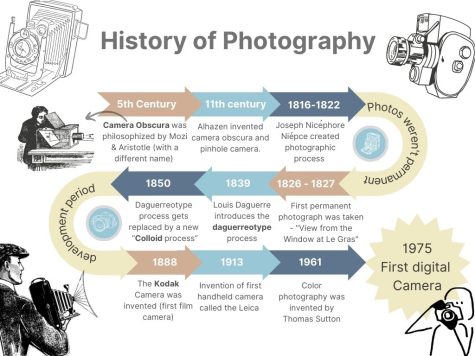The History and Advancements of Photography
May 3, 2023
 When you want to capture a moment in time, you reach for your phone or an easy access digital camera. Most people don’t think about the evolution of this technology because it seems so simple and so accessible. It is almost unimaginable that photography has history dating back to early philosophers in 400 and 300 BCE. Over the centuries scientists, philosophers, inventors, and artists contributed to the diverse development of photography as an amazing art and technology that is now used all over the world.
When you want to capture a moment in time, you reach for your phone or an easy access digital camera. Most people don’t think about the evolution of this technology because it seems so simple and so accessible. It is almost unimaginable that photography has history dating back to early philosophers in 400 and 300 BCE. Over the centuries scientists, philosophers, inventors, and artists contributed to the diverse development of photography as an amazing art and technology that is now used all over the world.
Photography started with Mozi, a Chinese philosopher and the father of Mohism, who made the earliest reference to the “camera obscuras” effects in the 5th century BC. He found that because light moves in a straight line, the image appears to be turned upside down and from right to left. After Mozi, the Greek philosopher Aristotle noted his discovery that when sunlight passes through a pinhole, he could make the sun appear to be upside down. This is a similar concept to the camera obscura (“History of Camera Obscura”). Even Leonardo da Vinci mentioned the camera obscura in his writing “Codex Atlanticus,” These are some of the most well-known early philosophical mentions of the camera obscura which would lead to the discovery of modern-day cameras and photography.
All of these philosophers noticed how light travels and how it gets altered into a projected image, but none of them proposed the use of a screen to enable the projection of an images from one side of the hole onto the other. It wasn’t until the 11th century where an Iraqi astronomer, physicist, and mathematician named Alhazen (or Ibn al-Haytham) was able to do so. Using candles, Alhazen conducted experiments to help him describe how an image is produced when light waves move in straight lines (“History of Camera Obscura”). His research led him to his discovery and creation of the camera obscura and the pinhole camera.
Centuries passed and inventors made improvements on the camera obscura, however in the early 1800s, the development of photography took a turn. From approximately 1813-1822 a French inventor named Joseph Nicephore Niepce experimented with many light sensitive materials which led him to create the first photographic development process (Heckmann). Getting inspiration from other inventors like Carl Wilhelm Scheele and Johann Heinrich Schulze, Niepce was aware that silver salts would darken and even alter characteristics when exposed to light (Gregory). But like previous inventors’ results, he never discovered a means to make these his modifications permanent. Even after this setback, Niepce did not give up. He continued to work with other varying compounds before settling on a “film” manufactured from “Bitumen of Judea”. This “bitumen,” also referred to as “Asphalt of Syria,” is an oil that is semi-solid and resembles tar. It was discovered to be the ideal material for Niepce to use when combined with pewter (an alloy of tin). He could make a permanent image on this surface using the wooden camera obscura box, even though it came out really blurry. Niepce called this method “heliography”. This discovery led to the establishment of the first permanent photograph in 1826-1827, they call it the “View from the Window at Le Gras” (Heckmann). After his success, Niepce started working more closely with a colleague and good friend of his, Louis Daguerre, where they continued to experiment with different compounds, but they always ended up going back to silver and working off it.
After Joseph Nicephore Niepce death in 1833, Daguerre continued to work to find an easier process of photographic development. With the continuous experimentation with silver, Daguerre eventually made a breakthrough in 1839. Louis Daguerre created the Daguerreotype, which is a very early form of our modern camera (Library of Congress). The photograph taken would be exposed to light for a long time, then the photographer would apply mercury vapor and heated seawater to it in a dark room so it could set. It is a long process, but it would eliminate any silver iodide that was not altered by the light, leaving a fixed camera image behind (Gregory). This innovation gained enough popularity and attention that the French government bought the rights to this camera design from Daguerre and shared it with the world as a “gift”. This promotion from the French government only increased the interest in this technology and furthered its development.
The Daguerreotype camera was the first mass produced camera and the first to become owned by many, but in 1850 it got replaced by a new process called the “Colloid process” (Gregory). The exposure time needed in cameras was shortened, and the photos were much clearer as a result. The exposure time was so fast, that a “shutter” had to be created so that the plate could be swiftly exposed to light before being blocked again. This process allowed for more photos to be taken in a shorter time frame. The Colloid process might have replaced the Daguerreotype, but it never gained as much popularity as the previous method did. It wasn’t until film was invented in 1888 with the Kodak camera that historians acknowledge the next important innovation of photography. The Kodak camera was invented by George Eastman, an American entrepreneur (“Kodak”). His camera would take negative photos, like cameras in the past. However, the images were clear like daguerreotypes, and the exposure length was measured in fractions of a second. This particular innovation revolutionized the camera industry. To obtain your photos, the Kodak film needed to be kept in the dark box, then the camera would be sent back to Eastman’s business so they could process the images. Once processed, the photos would be sent back to the owners. This seemed like a risk to the customers, but Eastman’s company’s slogan “you press the button… we do the rest” captured their attention and eased their fears (Gregory). The Eastman Kodak Company grew to be one of the biggest businesses in the country, and Eastman became one of the richest people. One of the company’s biggest successes was in 1900 when they produced the Kodak Brownie, it was the most affordable high-quality camera for the middle class. Since the price of this camera was not very high, it became widely used to record special occasions, and as the price to develop images decreased people started taking more photos more often for less special occasions (“Kodak”).
All cameras, despite their innovations so far have all had one aspect in common. They were all pretty big and heavy. This dynamic made it difficult for customers to have easy access to the technology and get the results they want. But thanks to the Ernst Leitz Optische company the restrictions on photography decreased significantly when they introduced their prototype of the Leica in 1913 (Gregory). However, a small set back that put a pause on the development of this camera was the first World War, but when the war was over, they picked back up on their progress. When this small lightweight camera with very high-quality lenses hit the market in 1925, it grabbed the attention of many photojournalists because it “offered them the freedom to shoot dynamically” (Hencz). This camera was also popular because it has a thin and light design with the addition of detachable and collapsible lenses. The Leica became the portable camera that all other manufacturers tried to imitate (Wade). Today, when we compare the Kodak camera and the Leica it is said that “While Kodak’s cameras may have been the most popular of the day, Leica’s changed the industry permanently” (Gregory).
Photography that can capture and reproduce color is known as “color photography.” Thomas Sutton took the first color photograph in 1961 using the three-color technique proposed by James Clerk Maxwell in 1855 (Touchette). The three-color technique is a multi-step process where the photographer takes a series of the same photo through three different colored plates, red, green, and blue (“Color Photography”). The Kodak company had been experimenting with self-regulating color film and as a product they created “Kodachrome” film, but it ended up being too complicated and expensive (Gregory).
The last notable landmark in the advancement of photography history before the 2000s is the first digital camera created in 1975. Although the concept of digital photography was first proposed in 1961, a functioning prototype wasn’t produced until Kodak engineer Steven Sasson worked with a team of engineers to work on this endeavor. His invention from 1975 recorded images in black and white onto a cassette tape. “This first digital camera was made possible by using a “charged-coupled device.” (CCD) developed in 1969 by Willard S. Boyle and George E. Smith” (Gregory). When exposed to light, the electrodes in the device would change voltage to produce an image. With this accomplishment, digital photography was born.
From the point of the development of digital photography, photographic advancements came at a rapid pace. Digital cameras, cameras on smart phones, and digital photo editing are just a few of the technologies that we use almost daily. The philosophical beginnings of photography was the art and the creativity that fueled the imaginations of inventors which motivated their prototypes and inventions. None of this would be possible without acknowledging the rich history of photography that is filled with both art and science.
Works Cited
“Color Photography: History, Techniques, & Editing Tips | Adobe.” Www.adobe.com, www.adobe.com/creativecloud/photography/discover/color-photography.html.
Hencz, Adam. “Agents of Change: Leica. How the Iconic Camera Changed Photography.” Artland Magazine, 12 Feb. 2021, magazine.artland.com/agents-of-change-leica-how-the-iconic-camera-changed-photography/. Accessed 9 Apr. 2023.
Gregory, Thomas. “The First Camera Ever Made: A History of Cameras.” History Cooperative, 4 Feb. 2022, historycooperative.org/first-camera-the-history-of-cameras/. Accessed 29 Nov. 2022.
Heckmann, Chris. “When Was Photography Invented – a Quick History Lesson.” Studiobinder, 1 May 2022, www.studiobinder.com/blog/when-was-photography-invented/. Accessed 7 Apr. 2023.
Wade, John. “The Leica I: The Camera That Changed Photography.” Shutterbug, 13 July 2015, www.shutterbug.com/content/leica-i-camera-change-photography. Accessed 9 Apr. 2023.
Library of Congress. www.loc.gov/collections/daguerreotypes/articles-and-essays/the-daguerreotype-medium/?scrlybrkr. Accessed 27 Jan. 2023.
Touchette, Amy. “A Quick History of Color Photography (for Photographers).” Photo & Video Envato Tuts+, 8 June 2017, photography.tutsplus.com/articles/the-reception-of-color-photography-a-brief-history–cms-28333. Accessed 9 Apr. 2023.
“Kodak.” Www.kodak.com, www.kodak.com/en/company/page/george-eastman-history.

